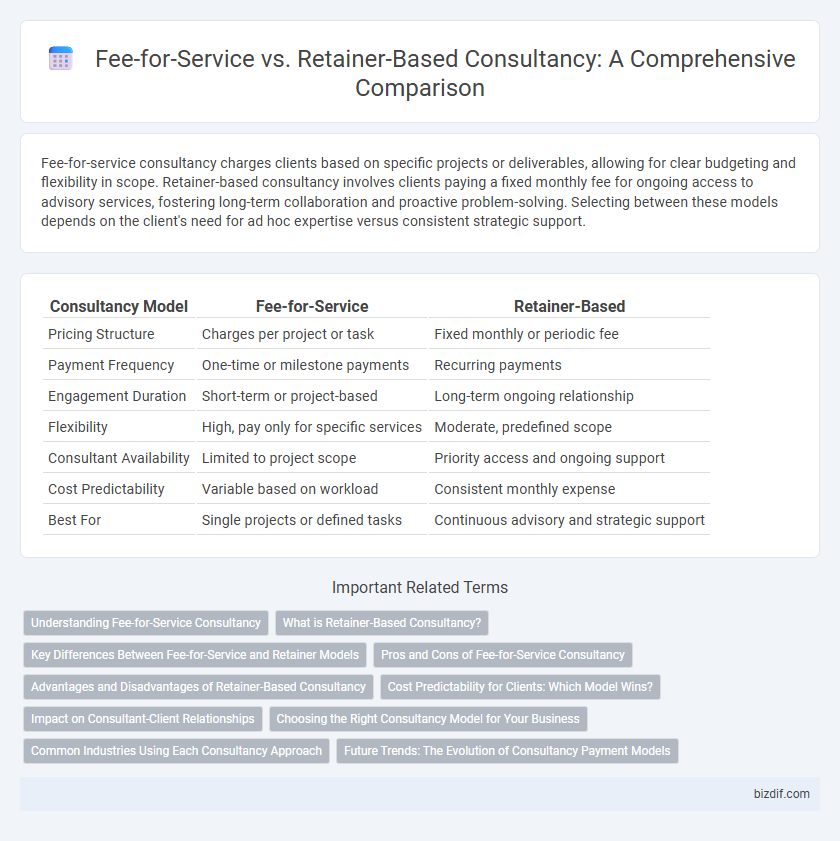Fee-for-service consultancy charges clients based on specific projects or deliverables, allowing for clear budgeting and flexibility in scope. Retainer-based consultancy involves clients paying a fixed monthly fee for ongoing access to advisory services, fostering long-term collaboration and proactive problem-solving. Selecting between these models depends on the client's need for ad hoc expertise versus consistent strategic support.
Table of Comparison
| Consultancy Model | Fee-for-Service | Retainer-Based |
|---|---|---|
| Pricing Structure | Charges per project or task | Fixed monthly or periodic fee |
| Payment Frequency | One-time or milestone payments | Recurring payments |
| Engagement Duration | Short-term or project-based | Long-term ongoing relationship |
| Flexibility | High, pay only for specific services | Moderate, predefined scope |
| Consultant Availability | Limited to project scope | Priority access and ongoing support |
| Cost Predictability | Variable based on workload | Consistent monthly expense |
| Best For | Single projects or defined tasks | Continuous advisory and strategic support |
Understanding Fee-for-Service Consultancy
Fee-for-service consultancy involves charging clients based on specific tasks or projects completed, offering clear cost visibility and flexibility in service selection. This model allows clients to pay only for the expertise or deliverables they need without long-term commitments. Consultants benefit from transparent billing aligned with measurable outcomes, making it suitable for businesses seeking targeted, short-term solutions.
What is Retainer-Based Consultancy?
Retainer-based consultancy involves a client paying a fixed fee regularly to secure ongoing access to consultancy services, ensuring priority support and continuous strategic guidance. This model fosters a long-term partnership, allowing consultants to deeply understand the client's business needs and provide tailored solutions over time. Retainer agreements often include predefined hours of service or specific deliverables, promoting consistent collaboration and proactive problem-solving.
Key Differences Between Fee-for-Service and Retainer Models
Fee-for-service consultancy charges clients based on individual projects or specific deliverables, providing flexibility and clear cost expectations for each service rendered. Retainer-based consultancy involves clients paying a consistent monthly or periodic fee for ongoing access to consultant expertise and support, fostering long-term collaboration and proactive problem solving. Key differences include payment structure, client-consultant relationship duration, and scope of services, with fee-for-service suited for short-term needs and retainers ideal for continuous advisory roles.
Pros and Cons of Fee-for-Service Consultancy
Fee-for-service consultancy offers clients clear, project-specific billing, enabling precise budgeting and payment only for delivered outcomes, which enhances transparency and cost control. However, this model may lead to unpredictable expenses and limited ongoing support, potentially causing delays if new issues arise after project completion. Consultants face challenges in forecasting income stability, risking fluctuations based on fluctuating client demand and project availability.
Advantages and Disadvantages of Retainer-Based Consultancy
Retainer-based consultancy offers consistent income streams and fosters long-term client relationships, enhancing trust and ongoing strategic support. However, it may limit flexibility for consultants due to fixed commitments and potential mismatches between contracted hours and actual workload. This model benefits clients through prioritized access and continuity but can pose financial risks if service usage fluctuates unexpectedly.
Cost Predictability for Clients: Which Model Wins?
Fee-for-service consultancy offers clients flexibility by charging only for specific projects or tasks, but cost predictability can be challenging due to variable scope and unforeseen expenses. Retainer-based consultancy provides consistent monthly fees that enhance budget forecasting and financial planning for clients, ensuring steady access to ongoing advisory services. For businesses prioritizing cost predictability, retainer models typically deliver greater financial stability and transparency compared to fee-for-service arrangements.
Impact on Consultant-Client Relationships
Fee-for-service consultancy creates a transactional relationship where consultants are hired for specific projects, often limiting long-term collaboration and deeper understanding of client needs. Retainer-based consultancy fosters ongoing partnerships, enabling consultants to provide continuous strategic advice and adapt solutions to evolving business challenges. This model enhances trust, promotes proactive problem-solving, and aligns consultant incentives with client success over time.
Choosing the Right Consultancy Model for Your Business
Fee-for-service consultancy offers flexibility with payments tied to specific projects or deliverables, ideal for businesses seeking targeted expertise without long-term commitment. Retainer-based consultancy provides ongoing support and strategic advice through consistent monthly fees, benefiting organizations prioritizing continuous guidance and proactive problem-solving. Analyzing your company's budget, project scope, and need for sustained consultancy services is essential when choosing between these models.
Common Industries Using Each Consultancy Approach
Technology firms and marketing agencies frequently opt for fee-for-service consultancy, valuing project-based expertise and flexibility in budget allocation. Legal and financial services commonly adopt retainer-based consultancy to ensure continuous access to specialized advice and compliance support. Healthcare and engineering sectors often blend both models to address fluctuating project demands while maintaining ongoing strategic guidance.
Future Trends: The Evolution of Consultancy Payment Models
Fee-for-service consultancy remains prevalent for project-specific expertise, but retainer-based models are gaining traction due to their emphasis on ongoing strategic partnerships and predictable cash flow. Future trends indicate an increased hybridization of payment structures combining fixed retainers with performance-based incentives to align consultant-client objectives more closely. The evolution reflects a shift towards value-driven consultancy, leveraging data analytics and AI to tailor customized, outcome-focused service agreements.
Fee-for-service vs Retainer-based consultancy Infographic

 bizdif.com
bizdif.com